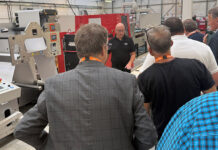Choosing the right coder can play a key role in a successful food packing operation, says Charles Randon, senior product manager of Linx Printing Technologies
THE food industry is characterised by continual new product development, with manufacturers seeking the latest innovation to create brand differentiation. This inevitably has a knock-on effect for packaging, with new formats and materials being introduced to help convey any point of difference and establish effective on-shelf impact.
The wide variety of products now available is also leading to shorter production runs, with the requirement to maximise flexibility on the line while maintaining efficiencies and throughput. The need for fast changeovers, and to switch production, machinery and staff between lines, increases the potential for expensive errors, both in terms of downtime and wasted product.
Coding and marking equipment can play a small but vital role in supporting the efficient running of a line. Code requirements may often be simple and driven by legislation – such as the need for a use by date, batch code or other identifier – but stringent regulations and the cost implications and damage to brand reputation of a product recall mean these are something no manufacturer can afford to get wrong.
The selection of the most appropriate coding and marking equipment can therefore be critical. For example, in fast-moving lines with frequent changeovers, intuitive touch-screen operation and on-screen help – including picture-led displays – will ensure quick and accurate message selection and printer set-up.
Coders that can be controlled remotely will also help to eliminate the potential for costly errors on the factory floor.
Speed and reliability of the coder will be other important criteria. A robust printhead and flexible conduit provides reliable operation in both static and moving printhead applications, where the printhead is traversing across a number of lanes. Features such as sealed printheads, self-cleaning capabilities and self-service maintenance help to ensure continuous production with reliable start-ups every time. A light, portable printer which can be easily moved between lines and set up quickly provides added flexibility in a multi-line, multi-product environment. A printer with a small footprint is a boon where space is an issue.
In crowded markets with many products jostling for impact on shelf, every millimetre of the packaging is valuable as a carrier of branding. This means the area where the code has to be printed may be small. Coders that can print at different angles and with the flexibility to code the top, bottom or side of a pack will meet the need for coding in tight spaces.
The factory environment is another consideration. Hygiene requirements can be met by the use of machines with an IP55 rating and stainless steel enclosure, with no dirt traps. Fast drying specialist inks can be invaluable where there is a risk of smudging through manual handling or where moisture may be present.
For smaller, artisan businesses seeking to increase production or secure their first order from a major retailer, code quality will be vital and may require a step-up from less flexible, non-digital coding methods. An entry-level coder that can deliver the necessary quality codes while ensuring ease of set-up and flexibility to be moved to where it is needed may provide the ideal starting point.
At the other end of the scale, companies with numerous product lines and a healthy NPD programme can benefit from future-proof coders, which provide the capability to print at increased line speeds, and to add more code content. This enables manufacturers to react quickly to changing trends without having to trial, test and gain expenditure approval for a new machine.
Another important consideration in the purchasing decision is to assess the overall cost of ownership. This takes into account both the initial purchase price, and the consumables and servicing costs over the years, together with any hidden costs of downtime caused by an unreliable printer or delays in set up and changeovers. Ultimately, as in any fast-moving production environment, manufacturers need to know that their coders can be trusted to perform their required tasks with consistent quality and without interruption. Taking the time to carefully assess the choice of equipment available will be crucial to selecting a solution tailored to their precise needs.













